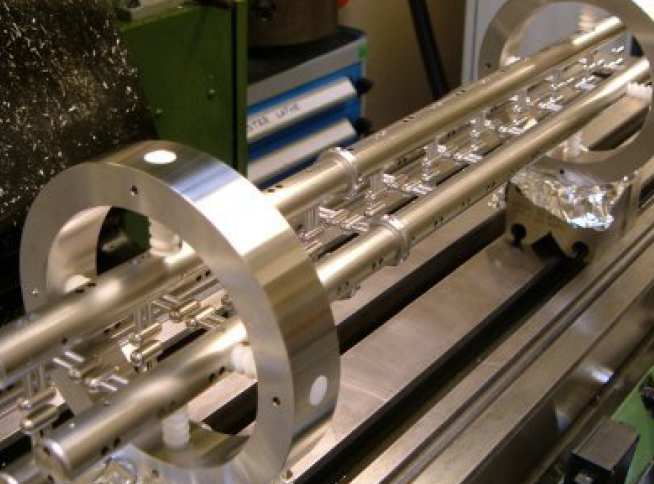
In a supersonic expansion source, gas expands through the nozzle of a high pressure valve into a vacuum chamber, thereby cooling to low temperatures. The mean speed of the gas is high, typically 300-1000 m/s, but the distribution of speeds is very narrow, corresponding to a low translational temperature. A wide variety of molecules can be introduced into the supersonically expanding gas, and their translational and internal degrees of freedom also cool to low temperatures, typically to about 1K.
This cold, high speed jet of molecules can be slowed down using a Stark decelerator. When a molecule moves into a region of high electric field it will gain kinetic energy if it is a high-field-seeker, and lose kinetic energy if it is a low-field-seeker. In the Stark decelerator, molecules move through a series of electric field gradients that are switched on and off so that the molecules are gradually slowed down. This deceleration process can work for both strong-field and weak-field seekers - it is simply a matter of choosing the correct switching sequence. However, strong-field-seekers are far more difficult to focus through the decelerator because they tend to crash into the electrodes where the field is strongest. This is unfortunate, since cold, heavy molecules are all strong-field seekers in the large electric fields of the Stark decelerator. We use an alternating gradient focussing scheme to transport our strong-field-seeking molecules through the decelerator. Each deceleration stage acts as a lens that focusses the molecules in one transverse direction, and defocusses them in the other. By alternating the focussing and defocussing directions of successive lenses, overall focussing is possible in both transverse directions.
Stark Deceleration
- Decelerating LiH
- Decelerating CaF and YbF
- Guiding molecules in strong-field seeking states
- Further reading
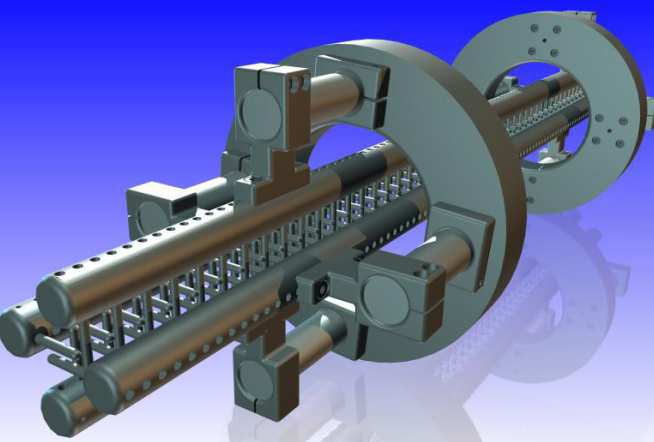
We have produced beams of cold LiH molecules in the first rotationally excited state, which is a weak-field seeking state. We decelerate these molecules to low velocity using a 100 stage Stark decelerator operated at a field strength of 100kV/cm. The electric field of the decelerator is switched on and off so that the molecules are always moving out of regions of weak field and into regions of strong field. This slows the molecules down, reducing their speed nearly to zero at the exit of the decelerator.
The figure below shows data demonstrating the deceleration of lithium hydride molecules. The molecules entered the decelerator with a speed of 420m/s. The graphs show the time of flight profiles of the molecules, measured by laser induced fluorescence at the exit of the decelerator, as the degree of deceleration is increased. The decelerated bunch moves to later arrival times as the molecules slow down. The arrows show arrival times predicted from a simple model, with the final speed shown next to each. The slowest molecules we have produced are moving at 53m/s, slow enough to begin trapping experiments.
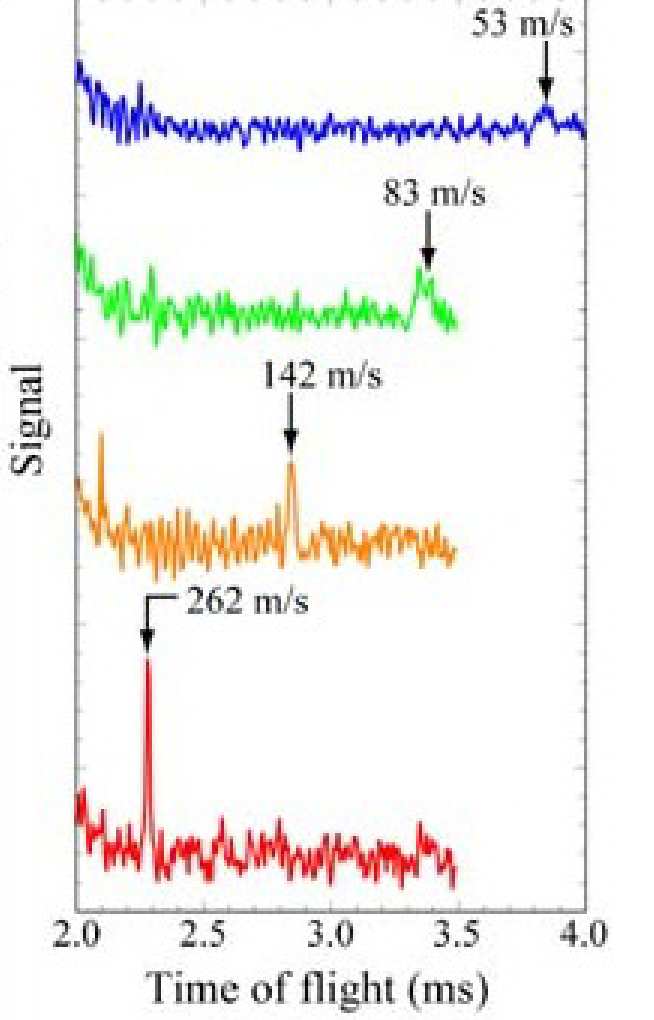
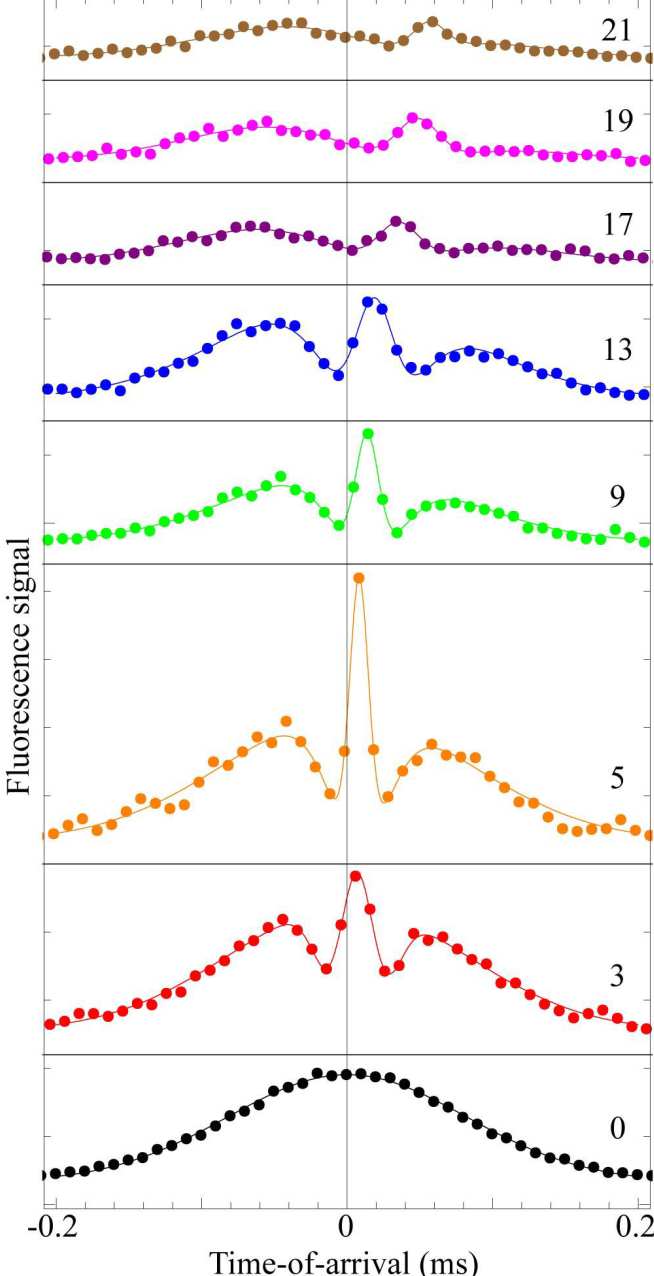
We have worked on the deceleration of YbF and CaF molecules, in weak-field and strong-field seeking states.
The figure shows the deceleration of ground state CaF molecules. The molecules enter the decelerator at a speed of 435m/s. The arrival time of the molecules at the detector tells us about their speeds. The figure shows this arrival time, relative to the central arrival time when the decelerator is turned off. A narrow peak appears in the time profiles, which is delayed more and more as the number of deceleration stages used increases. These are the decelerated molecules.
Most recently, in collaboration with Gerard Meijer's group, we have shown how to decelerate YbF molecules in a travelling wave decelerator.
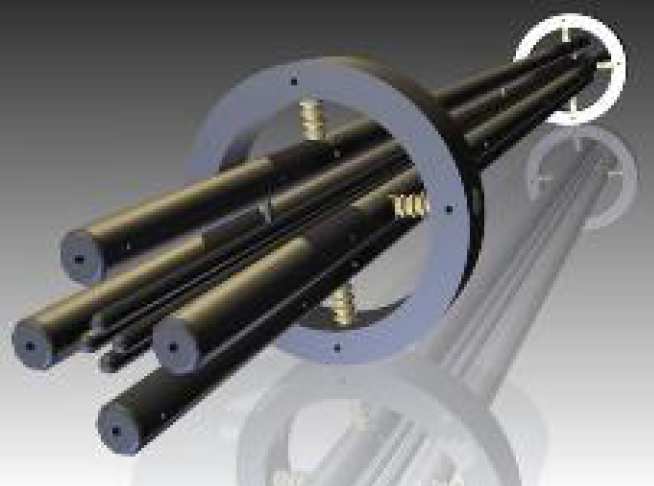
Ground state molecules can be transported in an alternating gradient guide. The operating principle is the same as for the decelerator. We have demonstrated a guide that has a four-rod geometry designed to minimize the lens aberrations which tend to reduce the transmission. The guide is useful for transporting molecules from a cold source, such as a buffer gas source.
Traveling wave deceleration of heavy polar molecules in low-field seeking states, N.E. Bulleid, R.J. Hendricks, E.A. Hinds, Samuel A. Meek, Gerard Meijer, Andreas Osterwalder, and M.R. Tarbutt, Phys. Rev. A 86, 021404(R) (2012)
Stark deceleration of CaF molecules in strong- and weak-field seeking states, T. E. Wall, J. F. Kanem, J. M. Dyne, J. J. Hudson, B. E. Sauer, E. A. Hinds and M. R. Tarbutt, Phys. Chem. Chem. Phys. 13, 18991 (2011)
Nonadiabatic Transitions in a Stark Decelerator, T. E. Wall, S.K. Tokunaga, E.A. Hinds, M.R. Tarbutt, Physical Review A 81, 033414 (2010)
Stark deceleration of lithium hydride molecules, S. K. Tokunaga, J. M. Dyne, E. A. Hinds and M. R. Tarbutt, New Journal of Physics 11, 055038 (2009)
Transport of pol ar molecules by an alternating gradient guide, T.E. Wall, S. Armitage, J.J. Hudson, B.E. Sauer, J.M. Dyne, E.A. Hinds, M.R. Tarbutt, Physical Review A, Vol. 80, 043407, (2009)